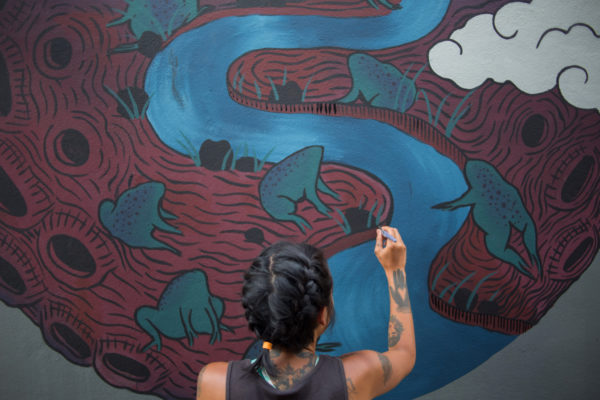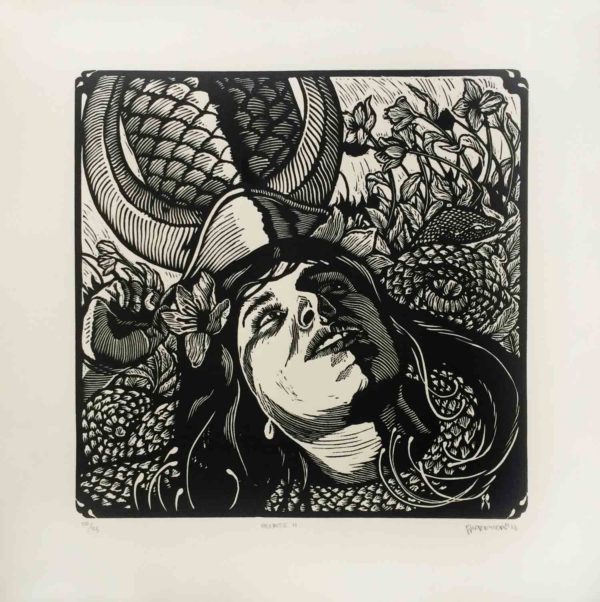Between the months of April and May of this year we(Kill Joy, Stinkfish and Mazatl) had the pleasure of being in Honduras for four weeks to work on the first stage of the Cuma Project, an independent initiative, in which we visited several rural communities in the Intibuca State. The state is located in the western part of the country, that borders El Salvador.
The initial goal of the project, that took a year of planning, was to visit a variety of communities that have been affected by hydroelectric dam mega-projects initiated by multinational corporations along with the Honduran government. We planned a series of interventions on school facades and communal houses. Our contact and guides, the COPINH (The Council of Popular and Indigenous Organizations of Honduras) is an organization that for more than 20 years have devoted themselves to the defense of the environment, the land, and the local indigenous culture and way of life of the Lenca, who live primarily in the region of Intibucá. The organization also functions as a network for other communities’ struggles on a National and International level.
On the 3rd of March, six weeks before we were to arrive to Honduras, the environmentalist, activist, co-founder and leader of COPINH, Berta Cáceres, was assassinated in her home in La Esperanza. The continuation of the project was in question due to the security conditions of the region, and specifically the communities we had planned to visit. None the less, we decided with the encouragement of the COPINH to carry on.
We met up in Tegucigalpa, the capitol of Honduras. From there we took a bus to La Esperanza, the capitol for the state of Intibucá, and the location for the headquarters of COPINH. Once we got settled in La Esperanza, we planned our work route for the following three weeks along with members of the organization. We organized to visit certain communities as safely as possible and work on our interventions despite the heated political environment, the constant harassment and threats, the several confrontations with legitimate and illegitimate representatives of the hydroelectric corporations and the assassination of Berta Cáceres.
The following three weeks we had the opportunity to visit the communities of Llano Grande, La Ceibita, Las Delicias, Las Mesitas and Rio Blanco. The majority of these communities can only be accessed by foot. Most also don’t have electricity and only a limited means of communication.
The images that accompany these words are a brief summary of the experiences that we had during those days on the road, in communities that are committed to the struggle for their land, their rivers and their way of life; communities that shared with us a warm meal, a swim in the river, a soccer match, their stories, history, knowledge, problems and victories.
The struggle and work of the likes of Berta Cáceres and organizations like COPINH lives on in Latin America and many other regions of the world.
[Para español dirigete al final de la pagina]


































Photo credits: Victor Galeano, Stinkfish, Mazatl and Kill Joy
—————————-
Entre Abril y Mayo del presente año estuvimos durante 4 semanas en Honduras trabajando en la primera etapa de Cuma Project, una iniciativa independiente en la que visitamos varias comunidades principalmente del Departamento de Intibucá en la región occidental del país, fronteriza con El Salvador.
La intención inicial del proyecto, que se comenzó a planear desde el año pasado, fu
é visitar diferentes comunidades que han sido afectadas por megaproyectos de represas hidroeléctricas liderados por multinacionales y el propio gobierno hondureño, realizando intervenciones en escuelas y casas comunales. Nuestro contacto y guía, el COPINH (por su sigla en español: Consejo Cívico de Organizaciones Populares e Indígenas de Honduras) es una organización que por más de 20 años se ha dedicado a la defensa del medio ambiente, el territorio y de la cultura indígena local, los Lenca, principalmente en la región Intibucá, aunque también la organización funciona como vinculo de lucha entre diversas comunidades a nivel Nacional e Internacional. Por su lucha en defensa del territorio del pueblo Lenca, especialmente una lucha en contra del Proyecto Hidroeléctrico Agua Zarca en el río Gualcarque, en los últimos años los integrantes del COPINH han sido víctimas de numerosos actos de hostigamiento, amenazas, persecución, asesinatos y criminalización por parte de agentes estatales y no estatales.
El pasado 3 de marzo, 6 semanas antes de nuestra llegada a Honduras, fue asesinada Berta Cáceres, ecologista y activista hondureña, cofundadora y líder del COPINH. Por un momento la realización del proyecto se puso en duda dadas las condiciones de seguridad de la región y en especial las comunidades que teníamos planeadas visitar, sin embargo decidimos, con el aliento del COPINH, llevar a cabo el proyecto.
Nuestro punto de encuentro fue Tegucigalpa, capital de Honduras, desde allí nos desplazamos hasta la Esperanza, capital del distrito de Intibucá y sede de del COPINH. Una vez instalados en La Esperanza, junto con integrantes de la organización, planeamos una ruta de trabajo para las próximas semanas, donde pudiéramos visitar comunidades de manera mas segura y en las que pudiéramos hacer las intervenciones a pesar del ambiente enrarecido y los constantes hostigamientos y amenazas después de varias confrontaciones con representantes legítimos e ilegítimos de las empresas hidroeléctricas y del asesinato de Berta Cáceres
En las siguientes 3 semanas tuvimos la oportunidad de visitar las comunidades asentadas en las regiones de Llano Grande, La Ceibita, Las Delicias, Las Mesitas y Río Blanco. En su mayoría, comunidades en las que solo se puede acceder caminando, que irónicamente no cuentan con suministro de energía eléctrica y con limitadas redes de comunicación.
Las imágenes que acompañan estas líneas son un breve resumen de las experiencias que tuvimos en estos días de camino, en comunidades comprometidas con una lucha por su tierra, sus ríos y sus tradiciones, que compartieron con nosotros un plato de comida, un baño en el río, un partido de fútbol, sus vivencias, historia, saberes, problemas y triunfos.
La lucha y el trabajo de personas como Berta Cáceres y organizaciones como el COPINH en América Latina y otras regiones del mundo continúa.






Really beautiful work, so inspiring! This project is awesome 🙂
Beautiful story and beautiful body of work.
Sorry to intrude I’m Callum, I’m a student at St.illtyds Catholic High School I’ve taken Art GCSE. I’ve taken interest in your work as I am studying print artists and I am inspired by your work! I was wondering if you could tell me what inspired you to make print work? And why have you based your prints on specifically skulls such as the giraffe. Thank you for your time
Sincerely, Callum Winter.